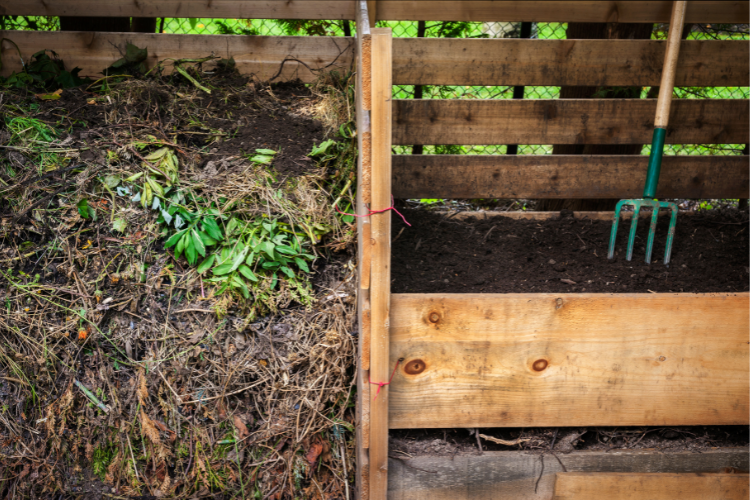How to Compost in an Apartment: 5 of the Best Indoor Methods for Small Spaces
Apartment composting is easier than you think! You don’t need a backyard—methods like vermicomposting, Bokashi, or a compost collection service make indoor composting possible, even in small spaces.
Whether you want high-quality compost for your plants or just an easy way to reduce food waste, we’ve ranked five apartment-friendly composting methods by cleanliness, convenience, and the quality and uses of the finished compost.
Method 1: Vermicomposting
Worms? Indoors? Hear us out. With the correct setup and a little know-how, you can have little wiggler friends help you compost. This method is a bit more complex, but the finished compost is highly nutrient-rich and great for plants.
How It Works
Get a container. You can create your own from a small tub and add holes around the edges (large enough for air flow but small enough that the wrigglers can’t crawl out). Or you can obtain a bin specifically designed for vermicomposting.
Create bedding from ripped-up pieces of paper or cardboard. Make sure all plastic is removed from the cardboard before adding it to the bin.
Add food scraps and monitor the moisture. Worms are a little picky and only like vegetable and fruit scraps. They also don’t do well with highly acidic scraps such as citrus or tomatoes.
Introduce the worms. Not all worms work in these systems, and you need a variety that likes living the bin life. The most common variety is red wigglers, which do well in enclosed spaces as long as they have a steady supply of food scraps.
Harvest the finished compost, which is called worm castings, and refresh the bedding regularly. This compost is very nutritious for plants!
Scoring Breakdown
Cleanliness - Taking care of worms and harvesting the compost can be a little messy. During general use, adding food scraps is an easy process between cleanings.
Convenience - It takes some extra set up, and you need to be thoughtful about what food items you add.
Finished Compost - Wormcastings are one of the best soil amendments! However, if you don’t require a lot of finished compost in your apartment, the end product will need to be taken elsewhere for use.
Method 2: Bokashi
Bokashi is a specific type of composting in an enclosed container, adding special microbes that will decompose the material in a controlled manner. Just throwing food scraps into a container and letting them sit will turn into a sloppy mess, but using this specific method ferments the material quickly and with control. While we’re often touting the need for oxygen in composting, this is a rare controlled process in anaerobic (without oxygen) conditions that can be effective because you control the types of microbes present.
How it works
You’ll need a special Bokashi bucket and the Bokashi microbe culture.
When you have the right bucket, add food scraps in layers, alternating the bokashi culture.
Once it’s full, you seal the bucket and let it decompose.
After a few weeks, you can take out the material and let the compost aerate for some time before using it for plants.
Scoring Breakdown
Cleanliness: This bokashi bucket has to be cleaned, and every addition of food requires adding the microbial culture.
Convenience: It takes time to set up, and you have to be mindful of how you add the food scraps to ensure the bokashi microbes are spread out correctly.
Finished Compost: The finished product requires extra steps to be usable. There will be extra material when it’s finished that you’ll need to deal with.
Method 3: Countertop Composters
Countertop composters’ process differs from traditional composting. Some of these machines heat, shred, and dehydrate food waste, and some include microbes during that process. While this material can be added to a compost pile or used as a plant topper, it could lack some of the aspects that make compost beneficial for plant growth. These products can help divert food waste from landfills, and some companies collect the dehydrated material for composting or animal feed.
How it works
Obtain the model you would like.
Add food scraps to the machine and follow the instructions.
Use the finished material or one of the other methods listed to finish composting the material.
Scoring Breakdown
Cleanliness: This process keeps food scraps easily contained and handles them in a way that can be less messy.
Convenience: It’s easy to add food scraps into the machine. It also requires electricity, and the dry material needs a place to go.
Finished Compost: The finished product may benefit from additional processing. Learn more from the USCC.
4. Community Drop-Off
Depending on availability, you might be able to take compost to a drop-off location. Many cities provide compost drop-off in the same way you can take recycling to a drop-off center. You’ll want to check your local city waste services for more information about availability, as you may not have them in your area, or they may require long-distance travel.
How it works
Obtain a compost bin to save your scraps in.
Once your bin is full, take it to the appropriate drop-off location and empty the bin.
Be sure to clean your bin between drops to prevent it from getting smelly.
Scoring Breakdown
Cleanliness: You have a container that requires cleaning and upkeep between drop-offs. The full bin needs to be handled and taken to a location, which can be messy.
Convenience: Taking the compost to a specific location takes extra time, planning, and a mode of transportation.
Finished Compost: You don’t have any finished compost afterward. If you do not require any, this should be fine. If you want it for your plants or patio garden, it’s something you miss out on.
5. Compost Collection Service
Composting services like Compost Nashville provide a straight-forward way to compost. Services like this collect your food scraps directly from your apartment, clean the bin for you, and can provide finished compost if you need it. This keeps the whole process clean, easy, and convenient.
How it works
Sign up for service in Nashville and Franklin, Tennessee. Or find a service in your area.
Have your bin delivered. You can fill it with food scraps, including fruits, vegetables, meat, dairy, and bones. You can also add anything that is BPI Certified compostable (think takeout containers, compostable cups, and more). Here is a full list of items we accept.
Put it outside your apartment door or in a common area on your scheduled pick-up day. When signing up, please provide instructions for where you would like the bin collected.
We collect your material and swap out your bin with a clean one.
You can order complimentary finished compost at any time to help fertilize your potted plants.
Scoring Breakdown
Cleanliness: Food scraps are naturally messy and may begin to smell the same way they would in the trash, but your bin is swapped for a freshly cleaned one at every pickup and you can add a second bin to reduce the need to open one if it becomes a bit smelly.
Convenience: Just fill your bin and set it out on pick-up day. You can also get a text and email reminder the day before.
Finished Compost:
You can receive a complimentary bag of compost at any time. If you don’t need it, no problem. We donate compost to local farms and gardens.










